On March 3, 1991, Rodney King was brutally beaten by LAPD officers — and he later became a reluctant symbol of racial tension in America.
On the night of March 3, 1991, George Holliday was asleep in his apartment near Los Angeles’ Hansen Dam Park when he heard a commotion across the street. Holliday got up, grabbed his video camera, and went to his balcony. He saw a number of police cars surrounding a white Hyundai below, and several cops gathered around a man. That man’s name was Rodney King. Holliday raised his camera, and pressed “record.”
As Holliday quietly filmed the scene from his balcony, the LAPD officers, most of whom were white, surrounded King, a 25-year-old Black man. Over the next nine minutes, Holliday filmed the cops using batons, stun guns, and their feet and fists to beat King, even once he was lying prone on the ground.
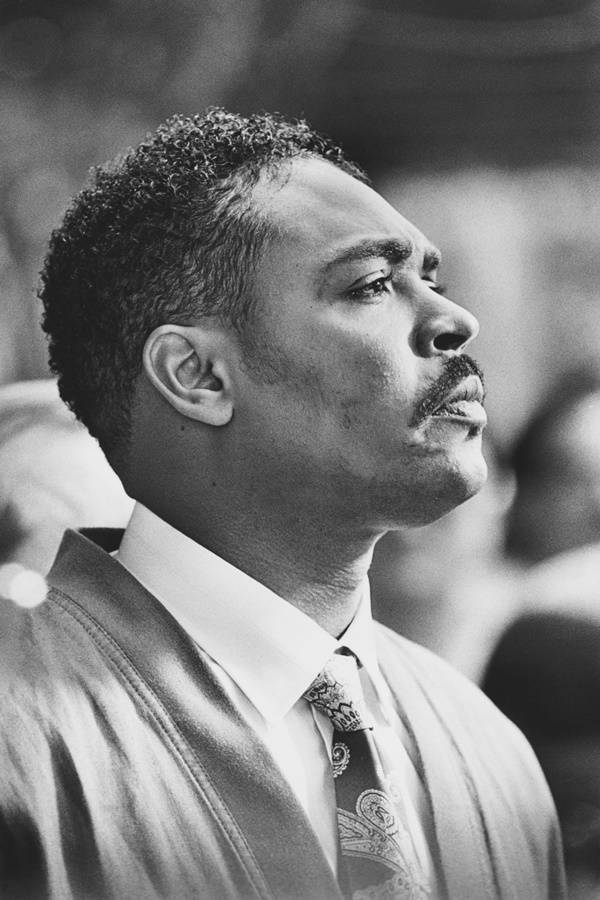
Ted Soqui/Corbis/Getty ImagesRodney King during the 1992 L.A. riots, when he appealed for calm.
In their official report, the police claimed King had suffered cuts and bruises “of a minor nature” during his arrest. But Holliday’s film, which he sold to a local news station, told the true story. The footage outraged people across the nation, an outrage which doubled after four LAPD officers — three of whom were white — were acquitted of using excessive force in the beating.
In fact, the officers were found not guilty on all counts, except for one assault charge against one officer that ended in a hung jury. Fury over the verdicts reached such a degree that they triggered the bloody L.A. riots.
Among the most infamous riots in American history, the L.A. riots also forced conversations about race and police brutality that Americans are having to this day. Meanwhile, Rodney King’s story has sometimes been lost.
Rodney King’s Life Before His Infamous Beating
Born on April 2, 1965, in Sacramento, California, Rodney Glen King grew up in Altadena with his parents and four older siblings. His childhood was far from idyllic. According to a Los Angeles Times story from 2012, his father Ronald was an alcoholic who often dragged King and his brothers with him to his nightly janitorial jobs. They helped clean, while their father drank.
As an adult, King also struggled with alcohol — and drugs — and had multiple run-ins with the law. In 1989, he was charged with attacking the owner of a market with a tire iron. He later pleaded guilty to robbery and was sentenced to two years in prison. By March 1991, King was out on parole and taking construction jobs wherever he could find them.
Rodney King might have lived the rest of his days in obscurity, but in March 1991, he had a fateful run-in with the Los Angeles Police Department. It would change his life — and the course of American history.
The 1991 Beating Of Rodney King

George HollidayA still from the infamous Rodney King tape, showing his violent beating by LAPD officers on March 3, 1991.
Shortly after midnight on March 3, 1991, the California Highway Patrol clocked Rodney King speeding down the 210 Freeway at more than 100 miles per hour. King had spent the night drinking with friends, and when he saw flashing lights in his rear view mirror, he panicked — he knew he’d get into trouble for drunk driving and violating his parole — and so he sped away.
As LAPD cruisers and a police helicopter joined the pursuit, King attempted to escape. He led the police on an eight-mile chase before he finally pulled over near Hansen Dam Park at 12:45 a.m. A group of LAPD officers, led by Sergeant Stacey Koon, then ordered King and his two friends to step out of the car. King’s two friends complied, but King moved more slowly and started to act erratically, taking a moment to wave at the helicopter whirring overhead, before he got down on his hands and knees.
Then, four Los Angeles police officers — Laurence Powell, Timothy Wind, Ted Briseno, and Roland Solano — attempted to force King down onto the ground. When King resisted, one of the officers shot him with a Taser.
Meanwhile, the commotion had awoken a plumber living nearby named George Holliday. Holliday got out of bed, grabbed his new Sony video camera, and stumbled to his balcony to see what was happening. Then, peering down at the flashing red and blue lights of the police cruisers surrounding King’s white Hyundai, Holliday lifted his camera and started to film.
Over the next nine minutes, Holliday recorded as LAPD officers beat King. After being Tased, King got up and tried to run. Police later alleged that he charged at Powell; King claimed that the police had shouted: “We’re going to kill you, n***er. Run!” Powell then struck King with his baton, knocking him down, and as King tried to rise, Powell and Wind struck him repeatedly.
“It felt like I was an inch from death,” King later recalled.
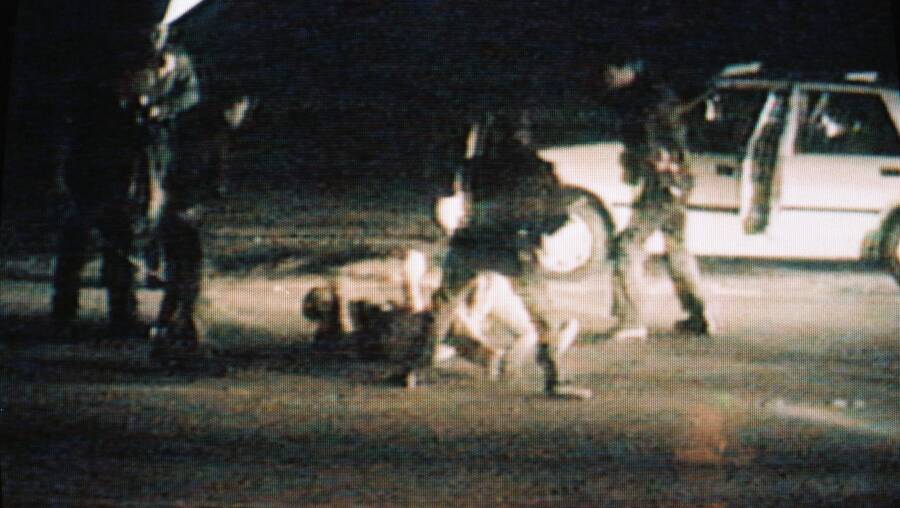
George HollidayThe beating of Rodney King continued even after the 25-year-old was lying on the ground.
The beating continued even when King was lying prone on the ground. Briseno stepped on King’s upper back, then the officers proceeded to beat him with their batons and feet as Koon looked on. Finally, after being hit over 50 times and suffering broken bones, skull fractures, and permanent brain damage, King was handcuffed and an ambulance was called for him.
Unbeknownst to Rodney King or the police officers, Holliday had captured most of the beating on tape from his balcony. He then sold the tape to the local TV station KTLA — which in turn sold the video to CNN.
How The Rodney King Tape Led To The L.A. Riots
The tape of the Rodney King beating made national news — and sparked national outrage. Though police brutality against Black Americans had a long history, few videos of such violence were widely shared. Americans might have seen photos of police attacking civil rights activists during the 1960s, but Holliday’s tape was one of the first to capture police brutality on video.
Millions viewed the tape, and many activists heralded it as a moment that would change the nation. At first, they seemed prophetic. King was soon released without charges; Koon, Powell, Wind, and Briseno were charged with assault with a deadly weapon and excessive use of force by a police officer. Powell and Koon were also charged with filing false reports.
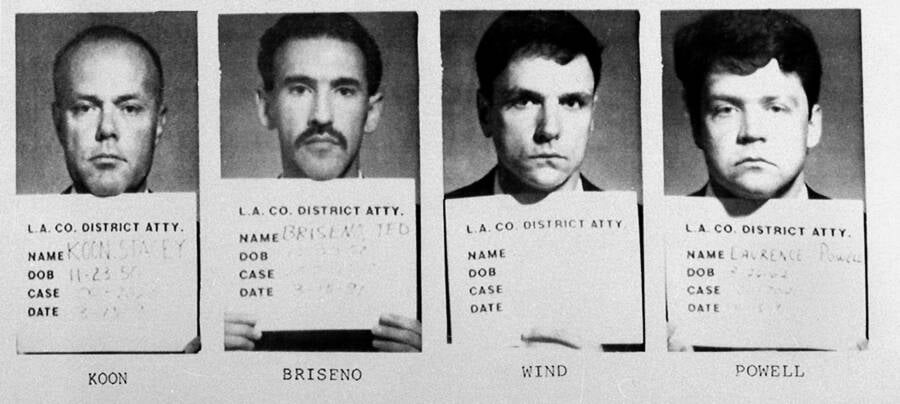
Public DomainMugshots of Sergeant Koon and Officers Briseno, Wind, and Powell. All four LAPD officers faced charges after the Rodney King beating was publicized.
But even though the LAPD officers stood trial in Simi Valley in Ventura County — the trials took place outside of Los Angeles to avoid the possibility of biased jurors — the trials came to a shocking conclusion. On April 29, 1992, the jury acquitted Koon, Wind, Briseno, and Powell of all charges (save for one assault charge against Powell that ended in a hung jury).
Hours later, Los Angeles erupted into riots.
The L.A. riots lasted six days as anger over the acquittals exploded across the city. Rioters set fires and looted local businesses. With the police overwhelmed, many store owners — notably local Koreans — were forced to defend themselves and their business properties. In one infamous moment, a group of Black rioters pulled white trucker Reginald Denny from his truck and beat him as a news helicopter aired the assault on live TV.
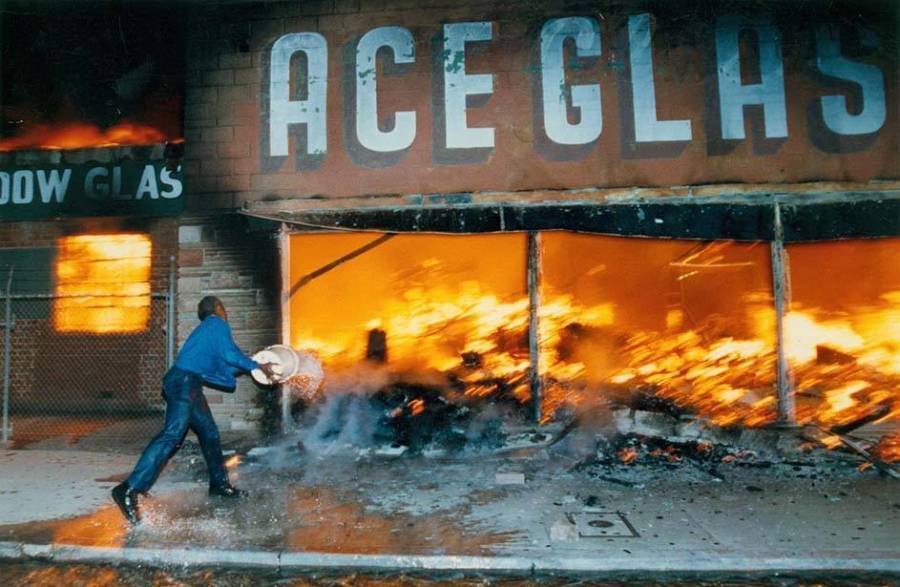
Getty ImagesA burning storefront during the L.A. riots. Ultimately, the six days of violence inflicted some $1 billion in property damage.
King, whose own beating had triggered the massive riots, pleaded for calm.
“People, I just want to say, can we all get along?” he said on May 1st. “Can we get along? Can we stop making it horrible for the older people and the kids?”
That night, King was echoed by U.S. President George H.W. Bush. Though he called the video of King’s beating “revolting,” he also called for calm in Los Angeles. The “senseless deaths” had to come to an end, Bush said, and he vowed to use “whatever force is necessary to restore order.”
The president added: “What is going on in L.A. must and will stop.”
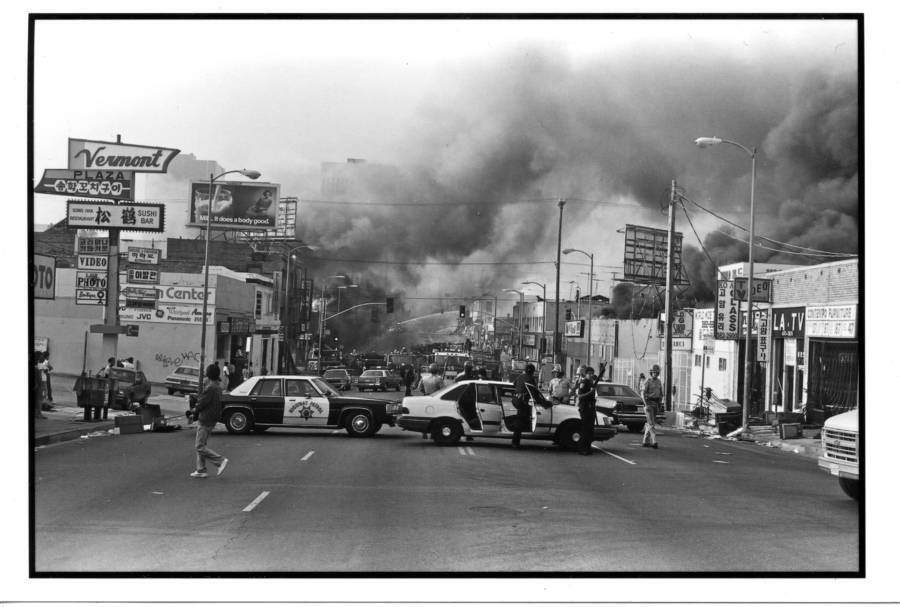
Gary Leonard/Corbis via Getty ImagesIn the end, it took some 10,000 National Guardsmen and 2,000 federal troops to help quell the L.A. riots.
Ultimately, about 10,000 National Guardsmen and 2,000 federal troops were sent to Los Angeles to help restore order in the city. By May 4th, the situation had largely calmed down — but not before the riots inflicted over $1 billion in property damage and killed more than 60 people.
But the story of Rodney King didn’t stop there.
Rodney King After The L.A. Riots
After the riots, the United States Department of Justice filed federal civil rights charges against Koon, Powell, Wind, and Briseno. On April 17, 1993, Koon and Powell were convicted of violating King’s civil rights and later sentenced to 30 months in prison; Wind and Briseno were found not guilty.
A few days later, on April 19th, Rodney King was awarded $3.8 million in compensatory damages in a civil lawsuit against the City of Los Angeles. It was a victory, but a small one: King had asked for $56 million, which would have represented $1 million for every time the LAPD officers hit him.
Rodney King had achieved some degree of justice, but he sometimes found his status as a symbol of racial tension in America difficult to handle.
“People look at me like I should have been like Malcolm X or Martin Luther King or Rosa Parks,” he told the Los Angeles Times in April 2012. “I should have seen life like that and stay out of trouble, and don’t do this and don’t do that. But it’s hard to live up to some people’s expectations.”
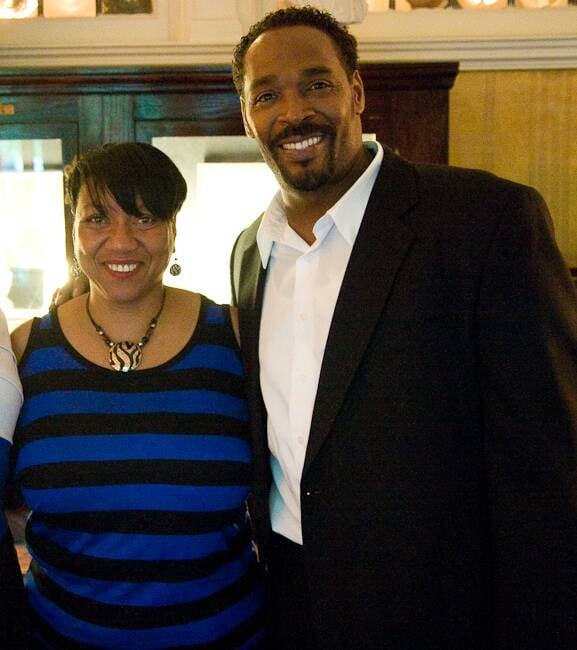
Justin Hoch/Justin Hoch for a Hudson Union Society/Wikimedia CommonsRodney King with his fiancée Cynthia Kelley, who had been a juror on his trial that awarded him $3.8 million.
Indeed, his trouble with the law continued for most of his life. Throughout the 1990s and early 2000s, King was arrested numerous times for driving while intoxicated, hit-and-run driving, use of the drug PCP, and domestic abuse involving his then-wife and daughter. King also cycled in and out of rehabilitation centers for alcohol and drug abuse, and even appeared on the television shows Celebrity Rehab with Dr. Drew and Sober House.
Rodney King’s life came to a sudden end on June 17, 2012, when the 47-year-old was found unresponsive in a swimming pool at his Rialto, California home. Authorities ruled his death an “accidental drowning,” but they also noted that alcohol, cocaine, marijuana, and PCP were all found in his system and they were contributing factors to his demise.
Though King had spoken to The Guardian about a month earlier about forgiving the police officers who’d beaten him years ago, Rodney King acknowledged the terrible pain that he had felt that night in March 1991.
“It was like being raped, stripped of everything, being beaten near to death there on the concrete, on the asphalt,” he remembered. “I just knew how it felt to be a slave. I felt like I was in another world.”
After reading about Rodney King, look through these photos of the 1967 Detroit riots. Or, discover the tragic story of the MOVE Bombing, when police in Philadelphia dropped explosives on a Black liberation group in 1985.





